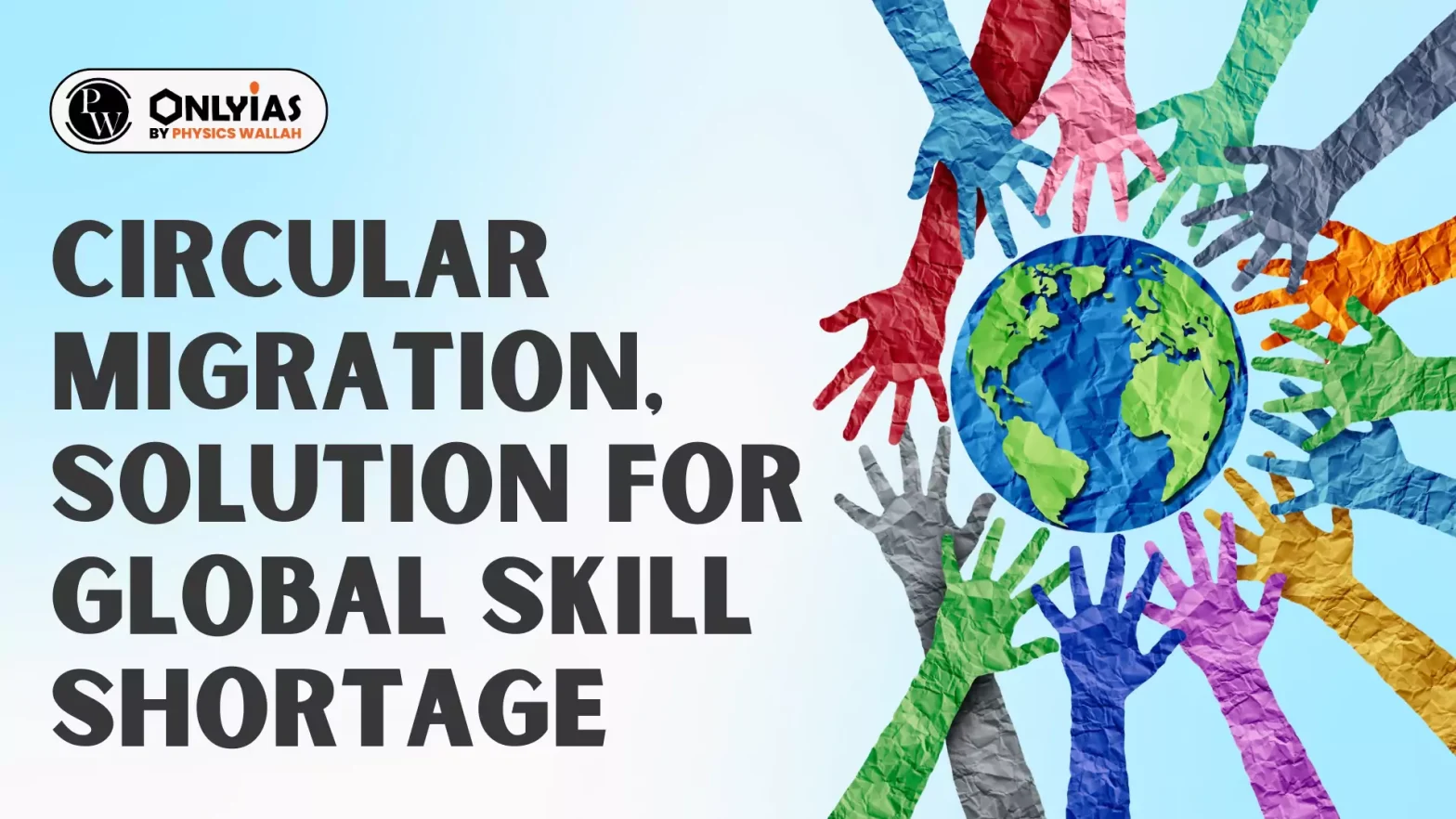The migration of 997 youth from Maharashtra, with high school certificates beginning a job in Israel, with a monthly salary of Rs 1.37 lakh exemplifies circular migration resulting in skill gain for both Israel and India.
Circular Migration Within India
- Between Rural and Urban Areas: Internal migration within India is primarily circular, with individuals moving back and forth between rural and urban areas for employment opportunities.
- Example: Construction sector saw notable increased employment, especially for rural males.
|
Enroll now for UPSC Online Course
About Circular Migration
- Definition: Circular migration is a repetitive form of migration wherein people move to another place (the destination country) and back (country of origin) according to the availability of employment.
- This migration can take place across international borders or between rural and urban locals.
- It is a phenomenon mostly among low-income groups who migrate to avail of seasonally available jobs in another country, city, place etc.
- Criteria for Circular Migration (Philippe Fargues):
- Temporary residence in the destination country.
- Possibility of multiple entries into the destination country.
- Freedom of movement between origin and destination countries during residence.
- Legal right to stay in the destination country.
- Protection of migrants’ rights.
- Demand for temporary labour in the destination country.
- Movement Frequency: As per the report on measuring circular migration by the United Nations Economic Commission for Europe Task Force, A person is considered a circular migrant after completing at least two loops between two countries (e.g., A to B, back to A, then A to B again).
Benefits of Circular Migration
- Circular Migration as a way to Address Global Skill Shortages And Poverty Alleviation In India: Circular migration facilitated by government-to-government agreements that protect the wages and social security of migrant workers.
- These agreements also ensure that migrant workers have a guaranteed return to their home country, fostering a sustainable migration pattern.
- Skill Enhancement: Skill enhancement for both sending and receiving countries.
- Triple-win scenario: Circular Migration benefits host countries by filling labour shortages, home countries by retaining skilled workers, and migrants through enhanced skills and wages.
- Remittances: Circular migrants tend to send back higher remittances compared to permanent migrants, benefiting their families and local economies, contributing to poverty alleviation back home.
- Example: Manual workers in the UAE, Saudi Arabia, Kuwait, Qatar and Oman contribute 40 per cent of the total remittances to India.
- As per the World Bank, India received USD 120 billion in remittances in 2023.
- Government Perspectives: Circular migration allows governments in destination countries to manage labour needs without permanently altering the population, as migrants are expected to return home.
- Public Acceptance: The notion that migrants will circulate back to their home countries can ease concerns in host nations.
Costs of Circular Migration
- Brain Drain: Loss of skilled workers from the home country, impacting human resources and development.
- Limited Skill Utilisation: Migrants may work in unskilled jobs abroad, gaining little experience that contributes to their home country’s development.
- Social Impact on Families: Temporary separation can lead to family disruption, especially for children left behind while parents work abroad.
- Exploitation: Recruitment may involve deception and exploitation, leading to forced labour and marginalisation in the host country.
- Example: In a tragic building fire in Kuwait, around 45 Indians and three Filipino nationals lost their lives. The incident occurred in a building that housed foreign workers in the Gulf Kingdom.
- In February 2021, the Guardian said 6,500 migrant workers from India, Pakistan, Nepal, Bangladesh and Sri Lanka had died in Qatar since it won its World Cup bid.
- Gender Issues: Traditional gender roles limit women’s participation in circular migration.
- Health Risks: Migrants face increased vulnerability to health issues due to isolation and poor living conditions, potentially spreading diseases to home communities.
- Language Barriers: Language differences can hinder communication and understanding, making it difficult for migrant workers to adapt to new work environments and meet employer expectations.
- This can often lead to reliance on middlemen and brokers, often resulting in exploitation.
- Example: Kafala system in the UAE, which grants employers considerable power over immigrant labourers, especially those in low-wage jobs.
- Skill-Matching Requirements: Government-to-Government (G-to-G) agreements for circular migration necessitate precise skill matching between Indian workers and the demands of receiving countries, complicating the selection process.
Check Out UPSC CSE Books From PW Store
Global Workforce Shortage and Opportunities for India
- Border Controls: Stricter immigration and labour controls have led to significant workforce shortages worldwide.
- Many countries are tightening regulations on foreign labour, leading to a reduced pool of available workers.
- Ageing Population in Developed Countries: The ageing demographic in developed nations such as Western Europe, Japan creates a significant opportunity for India.
- Critical Skill Shortages: Some Developed countries are facing substantial shortages of skilled professionals, particularly in sectors such as quantum computing, infrastructure development, and healthcare posing considerable challenges to their economic growth.
|
Initiatives taken by the Indian Government for Addressing Global Skills Gap via Circular Migration
- Labour Mobility Partnership Agreement : India has signed labour migration agreements with countries like Germany, Japan, Italy and Israel.
- This will enable Indian workers to work abroad for a specified period, typically around five years, before returning to India.
- Skill Development and Training: The National Skill Development Corporation (NSDC), in collaboration with the Maharashtra Institution for Transformation (MITRA), has developed Standard Operating Procedures (SOPs) to enable skilled youth in India to access higher-wage job markets abroad.
- Recognition of Prior Learning (RPL): National Skill Development Corporation identifies youth with specific skill sets required by partner countries like Israel and offers Recognition of Prior Learning (RPL) courses for booster training to enhance employability.
- Skills Acquisition and Knowledge Awareness for Livelihood (SANKALP) and Skills Strengthening for Industrial Value Enhancement (STRIVE): The SANKALP programme focuses on the district-level skilling ecosystem and the STRIVE project aims to improve the performance of ITIs are other significant skilling interventions.
- A Migration and Mobility Partnership Agreement (MMPA) is a formal arrangement between two or more countries designed to facilitate the legal and orderly movement of people.
- MMPAs are comprehensive in nature and cover a vast spectrum of mobility ranging from short stay visas, mobility of students, researchers, professionals for economic reasons, and preventing and combating irregular migration and trafficking in human beings.
- India has signed MMPAs with several countries to facilitate legal migration and mobility with Austria (January 2023), France, United Kingdom, Germany, Finland etc.
|
- TEJAS Initiative: TEJAS (Training for Emirates Jobs and Skills) is a Skill India project launched at Dubai Expo 2020 to skill, certify, and facilitate overseas employment for Indians, aligning the workforce with UAE’s market demands.
Recommendations to Enhance India’s Opportunities Amid Global Skill Shortages
- Facilitating International Mobility: Streamline visa application processes for students, professionals, and skilled workers to facilitate easier movement.
- Mutual Recognition of Qualifications: Establish agreements with other countries for the mutual recognition of educational and professional qualifications.
- Incentivise Return Migration: Create incentives for skilled workers to return to India after gaining international experience, such as tax benefits or grants for starting businesses.
- Reintegration Programs: Develop programs to help returning migrants reintegrate into the local economy and society.
- Expand Mobility Partnerships: Negotiate more Migration and Mobility Partnership Agreements (MMPAs) with countries facing skill shortages
Enroll now for UPSC Online Classes
Conclusion
India can leverage circular migration to become a global hub for skilled labour, benefiting from the experiences of returning migrants to enhance its workforce and drive global economic growth
![]() 5 Oct 2024
5 Oct 2024

